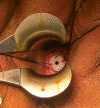Prevention of uterine perforation during intracavitary brachytherapy of cervical cancer
- PMID: 33897790
- PMCID: PMC8060953
- DOI: 10.5114/jcb.2021.105284
Prevention of uterine perforation during intracavitary brachytherapy of cervical cancer
Abstract
Purpose: Intracavitary brachytherapy (ICBT) is a part of standard treatment for loco-regionally advanced cervical cancers. ICBT requires a tandem applicator insertion through cervical canal into uterine cavity. Accurate placement through cervical canal, which is distorted by cancer, is crucial to successful treatment. The objective of this study was to investigate actual complication rate of a Smit sleeve insertion performed by experienced gynecologists in a tertiary referral center.
Material and methods: Clinical data of 328 patients with cervical cancer treated using ICBT, between January 2013 and August 2019, were retrospectively evaluated. Predisposing factors that could have increased the risk of uterine perforation were recorded. Pre-operative ultrasound was carried out for visualization of uterine curvature and selection of an appropriate Smith sleeve length. All applications were performed by a gynecologic oncology fellow or an expert gynecologist.
Results: 317 patients were suitable for analysis. Only one (0.3%) applicator placement resulted in uterine perforation. In two patients, Smit sleeve dislocated after first brachytherapy and reinserted. Adequate applicator placement was achieved, and treatment was completed as planned in 316 cases.
Conclusions: A cervical sleeve technic, which reduced the need for multiple insertions and placement of this instrument by an expert gynecologist minimize the risk of complication relative to historical controls.
Keywords: Smit sleeve; brachytherapy; cervical cancer; uterine perforation.
Copyright © 2021 Termedia.
Conflict of interest statement
The authors report no conflict of interest.
Figures
References
-
- Rose PG, Ali S, Watkins Eet al. . Long-term follow-up of a randomised trial comparing concurrent single agent cisplatin, cisplatin-based combination chemotherapy, or hydroxyurea during pelvic irradiation for locally advanced cervical cancer: a Gynecologic Oncology Group Study. J Clin Oncol 2007; 25: 2804-2810. - PubMed
-
- Han K, Milosevic M, Fyles Aet al. . Trends in the utilisation of brachytherapy in cervical cancer in the United States. Int J Radiat Oncol Biol Phys 2013; 87: 111-119. - PubMed
-
- Schaner PE, Caudell JJ, De Los Santos JFet al. . Intraoperative ultrasound guidance during intracavitary brachytherapy applicator placement in cervical cancer: The University of Alabama at Birmingham experience. Int J Gynecol Cancer 2013; 23: 559-566. - PubMed
LinkOut - more resources
Full Text Sources
Other Literature Sources

